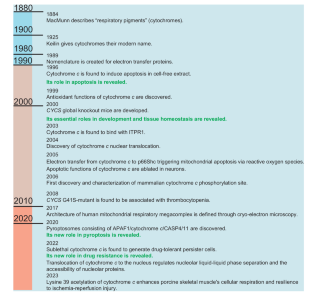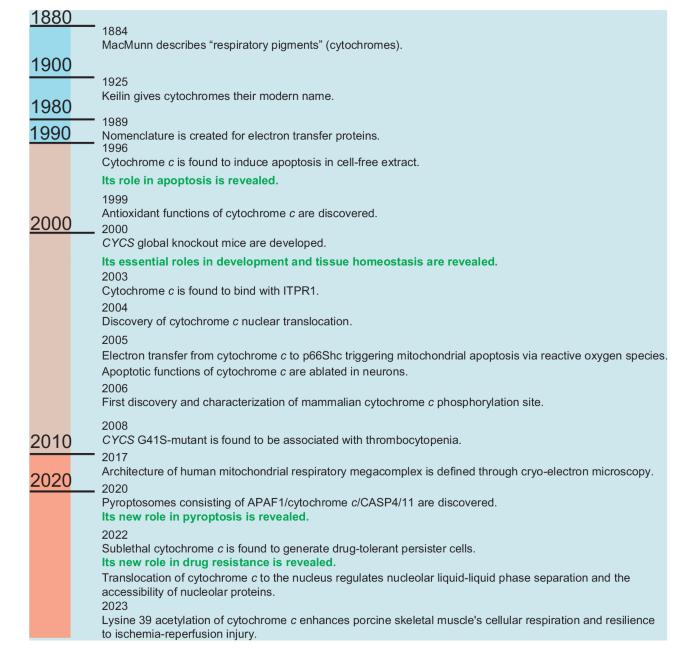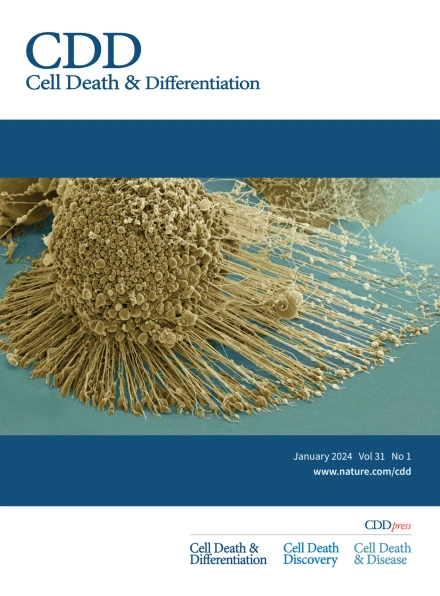细胞色素 c 在细胞死亡和疾病中的多种功能。
IF 13.7
1区 生物学
Q1 BIOCHEMISTRY & MOLECULAR BIOLOGY
引用次数: 0
摘要
氧化还原活性蛋白细胞色素 c 是一种带高正电荷的血红蛋白,可调节细胞的生死命运。在正常生理条件下,细胞色素 c 定位于线粒体膜间隙,而在特定病理或应激诱导条件下,其分布可扩展到细胞膜、细胞核和细胞外空间。在线粒体中,细胞色素 c 在电子传递链中充当电子载体,促进三磷酸腺苷的合成,调节心磷脂过氧化,并影响活性氧的动态变化。当细胞受到压力时,它可被释放到细胞质中,与凋亡肽酶激活剂 1(APAF1)相互作用形成凋亡小体,启动依赖于树突酶的细胞凋亡。此外,暴露于促凋亡化合物后,细胞色素 c 还有助于耐药持久细胞的存活。当细胞色素 c 转位至细胞核时,它能诱导染色质凝集并破坏核小体的组装。细胞色素 c 释放到细胞外空间后,可在细胞死亡过程中充当免疫介质,从而凸显其在细胞生物学中的多方面作用。在这篇综述中,我们探讨了细胞色素 c 在生理和病理反应中的不同结构和功能方面。我们总结了细胞色素 c 的翻译后修饰(如磷酸化、乙酰化、酪氨酸硝化和氧化)、结合蛋白(如 HIGD1A、CHCHD2、ITPR1 和 nucleophosmin)和突变(如 G41S、Y48H 和 A51V)如何影响其功能。此外,我们还概述了用于检测细胞色素 c 的最新先进技术,以及与该蛋白相关的潜在治疗方法。这些策略为个性化医疗带来了巨大希望,为神经退行性疾病、心血管疾病和癌症等多种疾病的靶向干预提供了机会。本文章由计算机程序翻译,如有差异,请以英文原文为准。


Diverse functions of cytochrome c in cell death and disease
The redox-active protein cytochrome c is a highly positively charged hemoglobin that regulates cell fate decisions of life and death. Under normal physiological conditions, cytochrome c is localized in the mitochondrial intermembrane space, and its distribution can extend to the cytosol, nucleus, and extracellular space under specific pathological or stress-induced conditions. In the mitochondria, cytochrome c acts as an electron carrier in the electron transport chain, facilitating adenosine triphosphate synthesis, regulating cardiolipin peroxidation, and influencing reactive oxygen species dynamics. Upon cellular stress, it can be released into the cytosol, where it interacts with apoptotic peptidase activator 1 (APAF1) to form the apoptosome, initiating caspase-dependent apoptotic cell death. Additionally, following exposure to pro-apoptotic compounds, cytochrome c contributes to the survival of drug-tolerant persister cells. When translocated to the nucleus, it can induce chromatin condensation and disrupt nucleosome assembly. Upon its release into the extracellular space, cytochrome c may act as an immune mediator during cell death processes, highlighting its multifaceted role in cellular biology. In this review, we explore the diverse structural and functional aspects of cytochrome c in physiological and pathological responses. We summarize how posttranslational modifications of cytochrome c (e.g., phosphorylation, acetylation, tyrosine nitration, and oxidation), binding proteins (e.g., HIGD1A, CHCHD2, ITPR1, and nucleophosmin), and mutations (e.g., G41S, Y48H, and A51V) affect its function. Furthermore, we provide an overview of the latest advanced technologies utilized for detecting cytochrome c, along with potential therapeutic approaches related to this protein. These strategies hold tremendous promise in personalized health care, presenting opportunities for targeted interventions in a wide range of conditions, including neurodegenerative disorders, cardiovascular diseases, and cancer.
求助全文
通过发布文献求助,成功后即可免费获取论文全文。
去求助
来源期刊

Cell Death and Differentiation
生物-生化与分子生物学
CiteScore
24.70
自引率
1.60%
发文量
181
审稿时长
3 months
期刊介绍:
Mission, vision and values of Cell Death & Differentiation:
To devote itself to scientific excellence in the field of cell biology, molecular biology, and biochemistry of cell death and disease.
To provide a unified forum for scientists and clinical researchers
It is committed to the rapid publication of high quality original papers relating to these subjects, together with topical, usually solicited, reviews, meeting reports, editorial correspondence and occasional commentaries on controversial and scientifically informative issues.
 求助内容:
求助内容: 应助结果提醒方式:
应助结果提醒方式:


